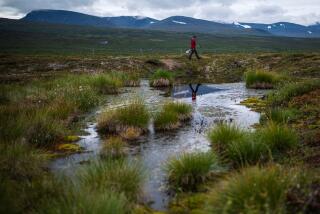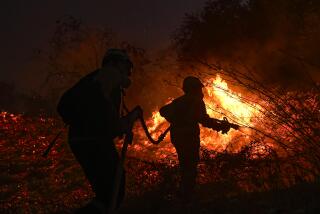Climate Change Accelerating, Report Warns
- Share via
The Arctic is experiencing some of the most rapid and severe warming on the planet, according to a new, eight-nation report -- the most comprehensive assessment of Earth’s fragile northern cap to date.
The report, a four-year effort involving hundreds of scientists, describes vast areas of melting ice, declining species and fading indigenous cultures.
“It’s affecting people up there now,” said Robert Corell, the American oceanographer who led the project. “And there are very serious consequences for people on the rest of the planet.”
The report states that climate change is accelerating sharply, spurred by human production of greenhouse gases, which have increased in the atmosphere by nearly 30% since the Industrial Revolution.
The 140-page report, released Monday, chronicles the many changes that have resulted as the Arctic has warmed in recent decades. Average temperatures there have risen nearly 2 degrees Fahrenheit in the last century -- twice the global average -- while winter temperatures have risen nearly 4 degrees.
Parts of Alaska and Russia have seen average winter temperatures rise 11 degrees since the 1970s and are at their highest in 400 years, according to the report. The amount of ocean covered by ice over the last three years has been the lowest ever recorded.
Among the most obvious changes are the melting of the massive Greenland ice cap and other Arctic glaciers and the decimation of northern forests by foreign insect invasions. Some coastal villages are jeopardized by erosion and rising seawater.
Many environmental groups hailed the Arctic report and said it was an urgent call for the United States, which has been reluctant to agree to international limits on greenhouse gas production, to join the efforts of other nations.
The report was produced by the Arctic Council -- comprising government representatives from Canada, Denmark, Finland, Iceland, Norway, Russia, Sweden and the United States -- along with scientists and members of indigenous groups.
Scientists have long puzzled over how much of the Arctic warming is due to human influence and how much is due to natural climate cycles.
For decades, an oceanic and atmospheric pattern known as the Arctic oscillation has been stuck in a phase that increases warming over parts of the Arctic. In recent years, the pattern has shifted to a more neutral state, “yet the Arctic is still warming, and we’re still losing sea ice,” said Mark Serreze, a researcher with the National Snow and Ice Data Center in Colorado, who contributed to the report.
“This is one of the pieces of evidence that we’re starting to see more clearly the effects of greenhouse warming,” he said.
Using computerized projections based on a “moderate scenario” of climate change, the authors say the Arctic faces an even warmer future, with half as much sea ice in summer by the end of the century.
Large sections of the report deal with problems faced by indigenous Arctic people, who tell of hunters falling through melting sea ice, declining reindeer herds and difficulty traveling in roadless regions with no snow for their snowmobiles and sleds.
In more developed areas of the Arctic, buildings, pipelines, runways and roads are beginning to crumble as the permafrost beneath them thaws and becomes less stable.
“Global warming connects us all,” said Sheila Watt-Cloutier, a Canadian Inuit who chairs the Inuit Circumpolar Council. “The Arctic is the world’s health barometer, and Inuit are the mercury in that barometer.”
Although the problems are immediate to many of the Arctic’s 4 million residents, the changes will affect the rest of the world as well, scientists said. Melting ice sheets and glaciers raise the sea level, which could affect low-lying cities in Florida and Louisiana, for instance. Melting ice exposes darker ground, which absorbs more sunlight and leads to greater warming, which in turn melts even more snow. This means that the reduction of snow and ice cover in the Arctic is likely to accelerate warming across the Earth, the researchers say.
The report is not all gloomy. A warmer Arctic could increase the numbers of some species, such as Arctic char, a fish. It could extend the growing season for wheat in Canada and open up now-treacherous sea routes, such as the Northwest Passage and the Northern Sea Route, which parallels Russia, for shipping and resource exploration.
More to Read
Sign up for Essential California
The most important California stories and recommendations in your inbox every morning.
You may occasionally receive promotional content from the Los Angeles Times.










